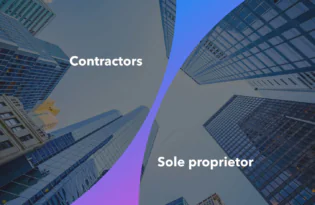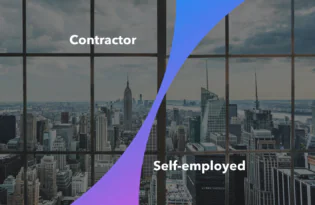How to hire international contractors
Wondering how to hire international contractors? Check out our primer on the ins and outs, including recommendations for getting started

The global talent pool has experienced consistent growth since the COVID pandemic of the 2000s. Despite “return-to-office” orders from several major companies, the data shows that freelance work is here to stay:
Freelancers in the global market, 2020-2025 (est)
(These figures are assumed in a general sense from various reliable sources; actual numbers may vary.)
It’s more important now than ever to understand how to hire international contractors and take advantage of excellent talent. This is easier said than done, however, as the process of hiring international contractors varies significantly based on the country in which you are hiring.
As a result, our team created a simple guide to provide business owners with an overview of how to hire international contractors.
How to hire international contractors, step-by-step
One of the central challenges of hiring an international contractor is the risk of misclassification; contractors are subject to different regulations for payment, benefits, and taxes, so there are significant penalties for inaccurately registering them as employees.
This means before you get started, you should be sure the role fits the requirements of a contractor, not an employee. So how do you know the difference?
International Contractor vs Employee: A Primer
| Contractor | Employee | |
|---|---|---|
| Control | The contractor determines where and how the work is completed | The employer determines where and how the work is completed |
| Training | No training is provided | The employer provides necessary training to complete the work |
| Profit/Loss | A contractor cannot make a profit or incur a loss from the project | An employee cannot make a profit or incur a loss from the project |
| Payment | Payment is project-based, typically in milestones. Paid via invoice | Payment is hourly or salaried, paid via check or direct deposit |
| Tools & Materials | The contractor provides any tools and materials to perform the work | The employer provides any tools and materials to perform the work |
If you are still unsure if the worker would qualify as a contractor, consult our IRS 20-point checklist for a more detailed breakdown of the distinctions.
From here, there are some standard steps to hiring an independent contractor. We’ve covered these steps in further detail before, but here are the broad strokes:
- Determine your budget. Freelancers are typically paid hourly, by project, or in milestones. Evaluate your needs and select the option that best fits your contract.
- Vet Applicants. You will need to collect a slew of documents like State ID/passport, business registration, W-88EN form, and background check materials (check with the agency performing your background check) to verify the applicant’s credentials.
- Draft a contract. It’s here that your legal representatives are essential; contracts need to include the project scope, payment terms, IP ownership, exit agreements, tax filing responsibilities, NDA clauses, and any subsections about local law.
- Onboard the new hire. Set up payment and invoicing, approve security & access clearance, and manage the contractor’s preferred communication channels.
What do I need to legally hire international contractors?
The previous steps are standard, no matter where you are hiring intentional contractors. When hiring internationally, however, you will need to make a few additional considerations:
| Currency conversion | Local entities |
|---|---|
| It’s probable, if not likely, that your contractor will require payment in a different currency than you currently use. A multi-currency wallet is ideal for navigating payments while reducing conversion fees, but it may be difficult to come by if you are hiring manually. | Unfortunately, hiring internationally may be subject to jurisdictional restrictions, limiting access to local talent. Additionally, companies hiring in a new country must stay compliant with local labor laws and classify talent correctly to operate with minimal risks. |
Unless you plan on using some kind of contractor management system, this process gets very time-consuming, not to mention expensive. Between the massive amounts of filing government forms and the hefty currency conversion fees, companies going the manual route should expect several months and thousands of dollars before their contractor can begin working.
What is a safe way to pay international contractors?
When determining how to hire international contractors, you likely have several options in front of you. Contractor management platforms offer a greater degree of utility. However, different contractors may involve different levels of need.
The table below outlines the four central payment options for paying international contractors (e.g., contractor management platforms, freelancer marketplaces, bank transfers, and digital wallets), comparing them across several key tools for hiring and managing contracts.
| Tool | Contractor Management Platform | Freelancer Marketplace | Digital Wallet | Bank Transfer |
| Multi-currency wallet | ✅ | ❌ | ✅ | ❌ |
| Localized payment | ✅ | ✅ | ❌ | ✅ |
| Bulk payments | ✅ | ❌ | ✅ | ❌ |
| Invoicing | ✅ | ✅ | ❌ | ❌ |
| Compliance Support | ✅ | ✅ | ❌ | ❌ |
| Tax form collection & reporting | ✅ | ✅ | ✅ | ❌ |
| Onboarding tools | ✅ | ✅ | ❌ | ❌ |
As this table might suggest, each of these options is best for a specific use case:
- Contractor management platforms are a reliable fit for companies seeking a comprehensive solution for international hiring. This could be companies seeking to shore up their compliance as they enter new markets for talent, smaller companies seeking to reduce costs by keeping staff to a minimum, or mid-market companies looking to expand their payment capabilities.
- Freelancer marketplaces work best for companies engaging with a few freelancers in a few countries. They provide compliance options to reduce misclassification risks, but they lack more robust payment options that support a larger workforce.
- Digital wallets are ideal for companies with an in-house legal team to handle compliance, since these options are limited to payment and tax services alone.
- Bank transfers are a good choice for companies handling one-off projects that don’t require consistent distribution. They eliminate monthly costs and reduce transaction fees to a single/limited payment.
Still have questions?
If you are still unsure how to hire international contractors, we understand. The process is difficult because it is rarely, if ever, the same due to local labor laws.
Working with a contractor management platform like Payoneer Workforce Management can help you manage those difficulties with an industry-leading AOR and reduce expenses while streamlining the international hiring process.
FAQs
1. How to legally hire international contractors?
To legally hire international contractors, draft a compliant contract that outlines the scope of work, payment terms, and intellectual property rights. Confirm their legal status in their country, collect the correct tax form (usually a W-8BEN), and ensure you’re not treating them like an employee. Using a contractor management platform can help with compliance and payments.
2. Do I need to issue a 1099 to a foreign contractor?
No, you do not need to issue a 1099 to a foreign contractor. Instead, you should collect Form W-8BEN from them, which confirms they are a non-U.S. person for tax purposes.
3. How do I pay an international contractor?
You can pay international contractors through secure methods, such as contractor management platforms like Payoneer Workforce Management, wire transfers, or global payment platforms like Payoneer. Choose a method that supports compliance, tracks payments, and handles currency conversion efficiently.
Disclaimer
- Skuad Pte Limited (a Payoneer group company) and its affiliates & subsidiaries provide EoR, AoR, and contractor management services.
- The information in this article/on this page is intended for marketing and informational purposes only and does not constitute legal, financial, tax, or professional advice in any context. Payoneer and Payoneer Workforce Management are not liable for the accuracy, or reliability of the information provided herein. Any opinions expressed are those of the individual author and may not reflect the views of Payoneer or Payoneer Workforce Management. All representations and warranties regarding the information presented are disclaimed. The information in this article/on this page reflects the details available at the time of publication. For the most up-to-date information, please consult a Payoneer Workforce Management representative or account executive.
- Availability of cards and other products is subject to customer’s eligibility. Not all products are available in all jurisdictions in the same manner. Nothing herein should be understood as solicitation outside the jurisdiction where Payoneer Inc. or its affiliates is licensed to engage in payment services, unless permitted by applicable laws. Depending on or your eligibility, you may be offered the Corporate Purchasing Mastercard, issued by First Century Bank, N.A., under a license by Mastercard® and provided to you by Payoneer Inc., or the Payoneer Business Premium Debit Mastercard®, issued and provided from Ireland by Payoneer Europe Limited under a license by Mastercard®.
Related resources
Latest articles
-
Planning to hire employees in France? Here’s a quick guide
Looking to hire employees in France for your U.S. company? Learn about employment in France and how Payoneer Workforce Management makes it simple to hire in France.
-
Planning to hire employees in Spain? Here’s a quick guide
Are you looking to hire employees in Spain? Learn about employment in Spain and how Payoneer Workforce Management can help American companies hiring in Spain.
-
How to hire employees in the Netherlands
Looking to hire employees in the Netherlands for your U.S. company? Learn about employment in the Netherlands and how Payoneer Workforce Management can help hire in the Netherlands.
-
How to hire employees in Australia
Looking to hire employees in Australia for your US company? Learn about employment in Australia and how Payoneer Workforce Management makes it easy to hire in Australia.
-
Planning to hire employees in Germany? Here’s a quick guide
Are you looking to hire employees in Germany? Learn about hiring in Germany and how Payoneer Workforce Management can help U.S. companies hiring in Germany.
-
Planning to hire employees in the Philippines? Here’s a quick guide
Wondering how an American company hires employees in the Philippines? Our guide covers how to hire employees in the Philippines and how we can help.
Disclaimer
Nothing herein should be construed as if Payoneer Inc. or its affiliates are soliciting or inviting any person outside the jurisdiction where it operates/is licensed to engage in payment services provided by Payoneer Inc. or its affiliates, unless permitted by applicable laws. Any products/services availability are subject to customer’s eligibility. Not all products/services are available in all jurisdictions in the same manner. Depending on your eligibility, you may be offered with the Corporate Purchasing Mastercard, issued by First Century Bank, N.A., under a license by Mastercard® and provided to you by Payoneer Inc., or the Payoneer Business Premium Debit Mastercard®, issued and provided from Ireland by Payoneer Europe Limited under a license by Mastercard. The Payoneer Business Premium Debit Mastercard® cannot be used at merchants or ATMs in Hong Kong or for HKD payments. If you are located in the EEA, all Payoneer Services will be provided to you by Payoneer Europe Limited, trading as Payoneer and regulated by the Central Bank of Ireland.
The information in this document is intended to be of a general nature and does not constitute legal advice. While we have endeavored to ensure that the information is up to date and correct, we make no representations or warranties of any kind, express or implied, about the completeness, accuracy, reliability or suitability of the information. In no event will we be liable for any loss or damage including without limitation, indirect or consequential loss or damage, or any loss or damage whatsoever incurred in connection with the information provided.
















